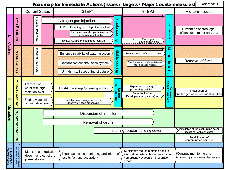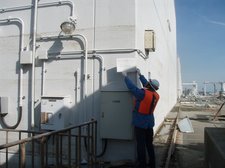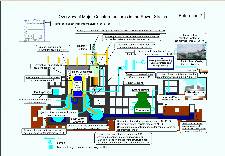 [1]On Sunday TEPCO released a rather ambitious plan for stabilization of the three reactors and the #4 spent fuel pit. The presentation by the utility is quite dense so let’s take a detailed look at it. The immediate plans involve shoring up the existing temporary reactor cooling systems and gaining control of the radioactive wastewater situation, particularly in Unit 2 where the containment is damaged and leaking water.
[1]On Sunday TEPCO released a rather ambitious plan for stabilization of the three reactors and the #4 spent fuel pit. The presentation by the utility is quite dense so let’s take a detailed look at it. The immediate plans involve shoring up the existing temporary reactor cooling systems and gaining control of the radioactive wastewater situation, particularly in Unit 2 where the containment is damaged and leaking water.
Intermediate term plans include the water entombment of Units 1 & 3 (filling the containment building with water up to the level of the fuel.) and attempting to grout the leak in Unit 2. Other plans include the installation of a water treatment plant to desalinate and decontaminate the water that is being pumped from the turbine buildings and Unit 2.
Longer term plans include building a containment structure over each reactor building, similar in concept to the sarcophagus erected over Chernobyl (but hopefully of higher quality.) The utility hasn’t stated as much but the illustration (above) seems to show a girder structure covered with some sort of tough fabric, perhaps something like they put on domed stadiums in the intermediate term, followed by concrete and steel buildings later.
TEPCO announced today that the French firm Areva has been given a contract to construct the on-site water processing facility. (This should be an American company but alas, our politicians chose to walk away from the nuclear option many years ago. Lots of good jobs gone bye-bye.)
The TEPCO documents detailing the plan are here [2], here [3], here [4] and here [5].
Short Term (three months)
-
Removal of debris sufficient to allow access to the #4 spent fuel pit and to reduce area radiation levels.
-
Fill the #1 and #3 containment buildings with water up to the level of the top of the core. This should ensure that the core, or what remains of it is fully covered.
-
Attempt to seal the leak in #2 containment. They discuss grouting it with a polymer. I somewhat doubt the viability of this plan, especially given the ambient radiation in the reactor building (more on that below).
-
Continue with nitrogen inerting of #1 and start inerting of #2 and #3 to prevent any possibility of a hydrogen explosion in any of the containment buildings.
-
Install a closed loop cooling system for all three units. This will replace the “feed and bleed” total loss system that they’re now using. The current system is generating contaminated water at the collective rate of about 100 gallons per minute. The closed loop system will consist of stamped plate heat exchangers and pumps to circulate the contaminated water in a closed loop and additional pumps to circulate sea water on the other side of the heat exchangers.
The graphic shows this being built inside the containment building but I think that to be impractical given the radiation readings that have been recorded in the buildings. More likely these will be build in new buildings constructed adjacent to the reactors. -
Re-establish closed circulation cooling to the #4 spent fuel pit.
-
Install the desalination and demineralizer plant to remove salt and radioactive contaminants from the recirculating and recovered water. The presence of sea water is going to greatly complicate this process. The use of sea water probably could not be avoided but now it’s going to come back to bite them in the form of a much more complex and costly water treatment plant.
-
Secure multiple sources of off-site power. This is in addition to the already accomplished task of moving the portable generators and pumps to high ground in case there is another major quake.
Mid-Term (3-6 months)
-
Cover reactor buildings with temporary covers to contain any further release of radioactive materials. Probably as described above.
- Seal and/or decontaminate the soil around the plant to eliminate airborne contaminated dust.
-
Reduce the total amount of water involved.
Longer-Term
-
Removal of intact spent fuel from the #3, #5 and #6 spent fuel pits. Place this fuel in secure dry storage.
-
Erect permanent buildings over the 4 units.
-
Cool the reactors to below 100 deg C. The term “cold shutdown” is being bantered about but it really doesn’t apply here since all 3 cores are at least partially destroyed. The major benefit of cooling to below 100 deg C is that the reactor no longer has to be pressurized. It can even be maintained at a negative pressure so that any leakage is in-leakage.
iRobot Entry
 [7]A US-supplied robot has been used for the past several days to peer around and take measurements inside the reactor building air locks. The radiation measurements don’t look promising. Levels around 7R/hr were measured just inside the Unit 3 and slightly lower values in Unit 1. These levels are, of course, too high to allow any significant amount of work to be done. Unless they use a lot of “jumpers”, that is. (A jumper is a person without significant previous radiation exposure that is used to do short term work in a high radiation field. He uses up his annual exposure limit and then he is transfered out or laid off.)
[7]A US-supplied robot has been used for the past several days to peer around and take measurements inside the reactor building air locks. The radiation measurements don’t look promising. Levels around 7R/hr were measured just inside the Unit 3 and slightly lower values in Unit 1. These levels are, of course, too high to allow any significant amount of work to be done. Unless they use a lot of “jumpers”, that is. (A jumper is a person without significant previous radiation exposure that is used to do short term work in a high radiation field. He uses up his annual exposure limit and then he is transfered out or laid off.)
Inside the air locks the radiation levels were 27R/hr in the Number One reactor, 1.2R/hr in Number 2, and 10R/hr in Number 3. This indicates that something quite hot is on the other side of the air locks. There is a pump adjacent to the air lock that handles reactor water so that may be the source.
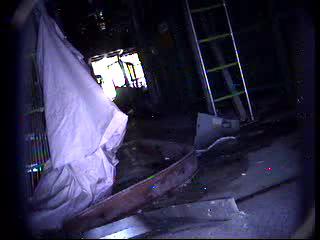 Or as can be seen in this photograph taken by the robot, the control rod drives are just inside the door (shiny tubes to the left under the white drape. These are also connected directly to the reactor and so may contain highly contaminated water. In any event, not much work is going to go on in that environment.
Or as can be seen in this photograph taken by the robot, the control rod drives are just inside the door (shiny tubes to the left under the white drape. These are also connected directly to the reactor and so may contain highly contaminated water. In any event, not much work is going to go on in that environment.
Since some of the utility’s plans as described above involve working in the reactor building, I don’t have a lot of hope for them achieving the time schedule they’ve specified.
Other Stuff
In this section I’m going to throw up some photos of the plant that show the damage done by the tsunami. As with all the photos on this page, these came from TEPCO
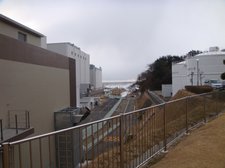 [8]Before photo of the rear of the plant
[8]Before photo of the rear of the plant
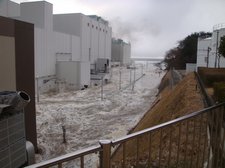 [9]“During” photo of the same area.
[9]“During” photo of the same area.
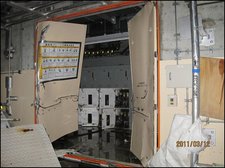 [11]Photo showing damage to a high security door and the MCCs (motor control centers) behind them. This is probably at the seawater intake system area. This photo shows just how much damage the tsunami did to vital systems. This is why TEPCO has decided to build an external reactor cooling system instead of trying to recover the in-plant system.
[11]Photo showing damage to a high security door and the MCCs (motor control centers) behind them. This is probably at the seawater intake system area. This photo shows just how much damage the tsunami did to vital systems. This is why TEPCO has decided to build an external reactor cooling system instead of trying to recover the in-plant system.
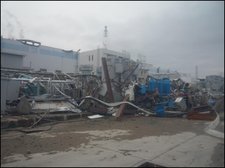 [12]Seawater intake area. The damage is unbelievable.
[12]Seawater intake area. The damage is unbelievable.
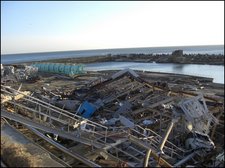 [13]Another view of the seawater intake area.
[13]Another view of the seawater intake area.
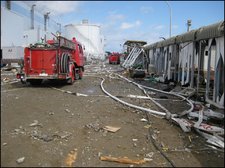 [14]Ocean side of a support building.
[14]Ocean side of a support building.
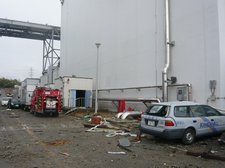 [15]Another support building. If you look very closely you can see the high water mark.
[15]Another support building. If you look very closely you can see the high water mark.
—
